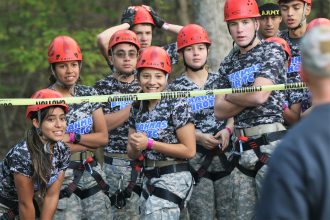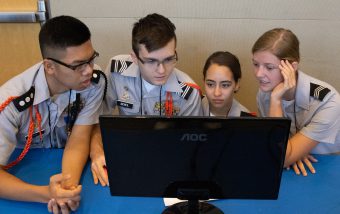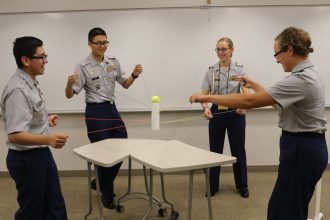By Commanding General John R. Evans, and Lindsay Grant
[embedyt] https://www.youtube.com/watch?v=xOjnmKqSvRY[/embedyt] The U.S. Army Cadet Command is not only committed to producing future leaders of the Armed Forces, they have inspired generations of students to become better citizens through Army Junior ROTC. With over 300,000 students in 1,700 units around the world (more than Air Force, Navy and Marine JROTC programs combined) Army JROTC has been a cornerstone of Cadet Command and integral to its mission.
Teams competed in the one-rope bridge event Saturday, 3 November, 2018 during the U.S. Army JROTC Raider National Championships. | Photo by Brenadine C. Humphrey, U.S. Army Cadet Command Public Affairs
A commonly held misconception about the program is that it is used to recruit students into the military upon completion of high school. In actuality, JROTC is not a recruitment program, it simply employs Army values, which are rooted in American values, to emphasize valuable life skills for students who seek a path to greater self-development and self-discipline. The program sponsors local, regional and national co-curricular activities for student participation including STEM and Cyber camps, Raider Challenges, Color Guard, Cadet Leadership Challenges and the JROTC Leadership and Academic Bowl (JLAB).

JROTC Cadets from across the country compete in the “Gauntlet” portion of the the JROTC Leadership and Academic Bowl at the Catholic University of America June 22. | Photo by Michael Maddox, U.S. Army Cadet Command Public Affairs
With technology at the heart of our communities and the human experience, JROTC encourages Cadets to be early adopters of modern advances. In the last fiscal year, JROTC purchased more than 400 VEX Robot kits to provide Cadets experience in engineering, mechanics and computer science. In addition to sending Cadets to study forensic science in Fort Jackson, South Carolina, JROTC partnered with the Department of Homeland Security and Richmond Public Schools to teach students Cyber Security, and had 68 Cadets receive their FAA 107 Drone Pilot License. By honing their focus on science, technology, engineering, mathematics and cyber (STEM-C), JROTC not only complements and enhances the high school curriculum, but also serves as a launching pad to higher education or technical colleges.
For such an expansive program to be successful, nearly 4,000 retired instructors are necessary to bring JROTC to life. Cadet Command and students in JROTC alike have world-class Cadre to thank for giving the program the push it needs to be truly influential. Their knowledge, positive mentality, excellent instructional capabilities and the unique ability to challenge and motivate students is what makes the program so successful. Students involved in JROTC statistically have higher attendance rates and are over 10 percent more likely to graduate from high school than their non-Cadet peers. Disciplinary rates for Cadets are lower and the high school drop-out rate among Cadets is less than 1 percent. With numbers like these, it’s no wonder the waiting list for schools hoping to obtain a JROTC program is over 270 strong.

Cadets from Francis Lewis High School, Fresh Meadows, New York, work to maintain balance during the leader reaction course exercise “Steeplechase” as part of JLAB June 23. | Photo by Michael Maddox, U.S. Army Cadet Command Public Affairs
Contrary to popular belief, JROTC is not a military recruiting program, but rather one of the nation’s largest and most versatile youth development programs. While 20-25 percent of JROTC Cadets will choose to serve the United States in the Armed Forces after high school, the U.S. Army Cadet Command is proudly committed to building college and career ready students, and citizens of character for our country’s future.
To learn more about JROTC Cadets or instructor opportunities, please visit www.armyjrotc.com.




